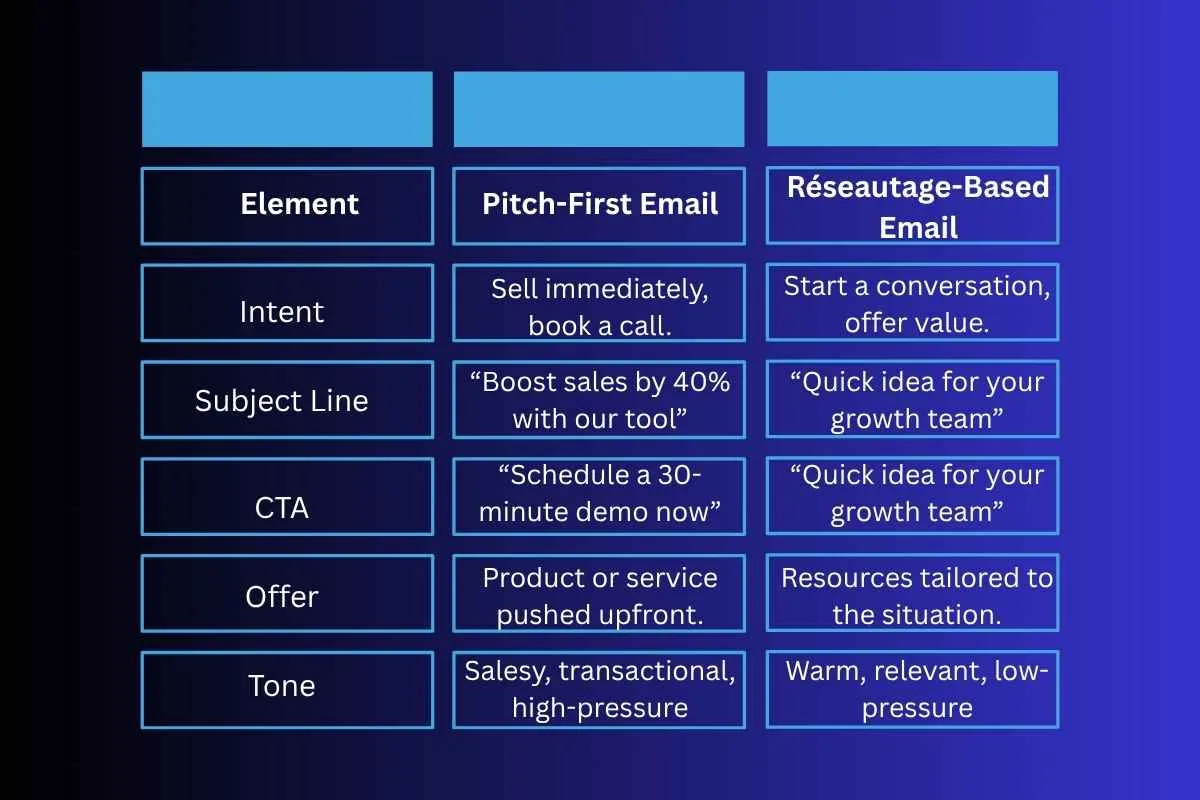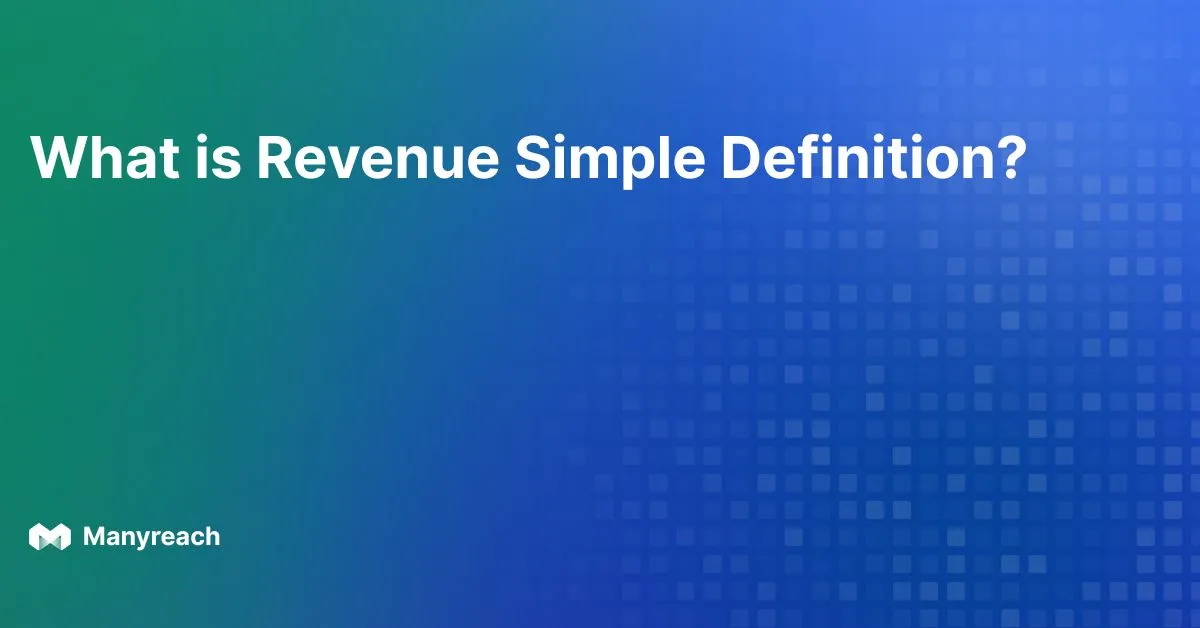Réseautage Definition in Cold Emails & Best Practices: 2025
.webp)
In cold emailing, réseautage is the act of building a professional relationship before pitching or asking for anything. It’s not just about reaching out; it’s about reaching out with context, relevance, and intent to connect, not sell.
Réseautage replaces the outdated sales-first approach with a connection-first strategy.
Instead of jumping into offers or product features, réseautage focuses on understanding the recipient, with starting a low-pressure conversation. It’s smart networking through email, without the small talk or spammy tone.
What is Réseautage?
Réseautage is French for networking. So when you build and maintain relationships with people to grow your professional, and personal network, you call it réseautage.
In cold email, réseautage is to introduce yourself to business prospects. It will help you build new relationships for better opportunities.

Why Réseautage Beats Direct Pitching in Cold Emails
Direct pitching often gets ignored because it lacks trust and context. Businesses are tired of random emails that push products without understanding their pain points.
Réseautage works better because:
- It shows you’ve done your homework.
- It builds familiarity before making an ask.
- It invites conversation rather than demanding time.
- It’s how real-world networking would happen, just in inbox form.
How to Apply Réseautage in Your Cold Emails
This is how you apply réseautage in your cold emails.
1. Research Before You Reach Out
Start by understanding who the recipient is.
First look at their recent LinkedIn activity, blog posts, or news mentions, and then find a specific reason to connect.
Bad ❌
“Hi, Have you heard about our product?…”
Good ✅
“I saw your recent post on hiring remote sales reps. And it sparked this idea I wanted to share.”
“Saw your recent post on hiring remote sales reps, and it gave me this idea I wanted to share.”
2. Personalize with Purpose
Personalizing isn’t just dropping your or your recipients’ name or company name. You have to mention something relevant to them; a challenge, goal, or achievement.
Example
“I noticed your team recently raised Series A. congrats on that! If you’re expanding sales, I thought you might find this onboarding guide useful.”
3. Keep the Ask Low-Pressure
Don’t request a 30-minute call right away. Offer value. Suggest a light next step.
Example CTA (Call to Action)
“Happy to send a 2-minute explainer! Worth a look?”
This kind of CTA aligns with the réseautage mindset.
4. Be Human in Tone
Write like you talk. No jargon. No hard sells. No “per my previous email” opening lines.
Avoid: “Leverage synergistic frameworks…”
Use: “Just thought this might be helpful given what you’re working on.”
5. Follow Up Thoughtfully
Don’t spam with “Just checking in…” Instead, follow up with added context or helpful info.
Better Follow-Up Examples:
“Saw you posted about your new product launch, congrats! I think this playbook might be helpful if growth is the next focus.”
“Hope your week’s off to a good start! I noticed you were hiring for your sales team, so I thought this guide on “Onboarding Reps Faster” might be useful.”
“Just came across your interview on [Podcast Name]. I loved your take on customer retention. Sharing a quick resource here that might complement what you’re already doing.”
The Difference Between Réseautage & Hard Pitch
The purpose of réseautage-style email is to connect with prospects. On the other hand, the goal of hard-pitch emails is to sell something as fast as possible.
Here’s a breakdown to show the primary differences between réseautage and hard-pitch:
Intent
For a pitch-first email, the goal is simple: sell something as quickly as possible. There's no real effort to understand the recipient or build any connection.
It’s a straight-up transactional move, assuming the person is ready to buy just because you reached out.
But in a réseautage-based approach the intent is more thoughtful. Instead of trying to sell right away, you're opening a door to a real conversation. It’s about relevance, trust, and offering something helpful before you ask for anything in return.
The focus is long-term, not just quick wins.
Subject Line
In pitch-first emails, the subject line usually gives away the sales intent immediately. It’s something like “Boost your revenue by 40%” or “#1 CRM solution for your team.”
They sound more like an ad, so it often gets ignored because it doesn’t feel personal or timely.
But in the réseautage-based emails, the subject line feels more like an email from someone you know.
For example: “Quick thought for your customer success team” or “Saw your hiring update, had an idea.”
It sounds like something worth opening, because it actually sounds like it was written for you.
Call to Action (CTA)
In a pitch-first email, CTAs tend to be direct. You’ll see things like “Book a 30-minute call this week” or “Schedule your demo now.”
It’s asking for your time right away without offering any real reason or context.
Whereas in réseautage-based emails, the ask is soft. Instead of pushing for a meeting, you’re simply offering to share something useful. “Happy to send over what worked for a similar team,” or “Let me know if you’d like the full playbook.”
It’s low-pressure and easy to say yes to.
Offer
In pitch-first emails the offer is the product itself. So there’s little effort to connect with the recipient. It’s basically: “Here’s what we do, interested?”
There’s no tailoring, no insight, just a straight sales pitch.
But if you read a réseautage-based email, the offer is value-first. You’re giving away a helpful resource, sharing a lesson learned, or showing an example from a similar company.
It makes the reader feel like you understand their situation and genuinely want to help, not just make a sale.
Why Réseautage Works
Réseautage works because it’s grounded in real connection.
It doesn’t feel like marketing, instead it feels like someone reaching out because they have something genuinely useful to share. So It lowers the defenses, builds trust, and gives people a reason to write back.
In a world flooded with sales pitches, that kind of approach stands out.
Here’s a comparative table for your better understanding:

What Makes Réseautage So Effective in 2025?
Buyers today deal with too many emails, and most of them are sales pitches with no personalization. That’s why hard-pitch often fails.
As of 2025 there’s no reliable metric on cold email open rates, but bounce rates can hover as much as 7.5% if emails aren’t well-targeted.
That’s why most cold emails often end up in spam, because they sound like mass marketing, not a real email.
This happens because most cold emails are:
- Written to sell, not to help
- Sent without context
- Copied and pasted across hundreds of contacts
That’s where réseautage helps.
Instead of pushing for a sale, it starts a conversation, and tries to build a professional relationship.
So it adds context that shows you’ve done your homework. Moreover, instead of asking for time, réseautage helps you to offer something useful to your prospects.
Buyers are more likely to reply when you’re helpful, relevant, and personal.

Frequently Asked Questions (FAQs)
1. What is the proper structure for writing a cold email?
The structure of a cold email typically follows this flow:
- Subject Line – Clear and relevant to catch attention.
- First Line – Personal hook based on research.
- Body – Brief value proposition or insight.
- CTA – A low-pressure call to action.
- Sign-Off – Friendly and professional.
This flow makes your email personalized, understood, and acted on.
2. What are the essential elements of a cold email?
The five core components of a professional email include:
- Subject line – The first impression.
- Greeting – Personalized opener (e.g., Hi Joe).
- Opening Line – Context or reason for reaching out.
- Email Body– The value or insight you’re offering.
- Call to Action – What you’d like the recipient to do next.
Stick to these for clarity and effectiveness.
3. What should you say in the first sentence of a cold email?
The opening line should establish relevance right away. It should be personal and tied to something the recipient cares about.
Some good examples:
- “Saw your recent feature in [publication] — loved the insights on hiring.”
- “Noticed you’re expanding into LATAM — curious how you’re handling localization.”
Start with them, not you.
4. What do the terms CC and BCC mean in email?
- CC (Carbon Copy): Sends a visible copy of the email to other recipients. Everyone can see who’s CC’d.
- BCC (Blind Carbon Copy): Sends a hidden copy to someone. Other recipients won’t know the BCC’d person got the email.
Use CC for team visibility and BCC for discretion.
5. What does CTA mean in email communication?
CTA stands for Call to Action. It is the part of your email that tells the reader what to do next.
Examples:
- “Would it make sense to explore this further?”
- “Want me to send you a 2-minute walkthrough?”
- “Open to a quick call next week?”
CTAs should be clear, specific, and low-pressure.
6. What is the 5-second rule in email writing?
This refers to the 5-second scan test, where someone must understand your email’s purpose within 5 seconds of opening it.
Tips:
- Keep subject lines up to 4 words.
- Use short paragraphs.
- Highlight value immediately.
- Avoid fluff or long intros.
If it takes more than 5 seconds to figure out why you're emailing, you're losing them.
7. What are the 4 C’s of writing a cold email?
The 4 C’s ensure your cold email is effective:
- Clear – Easy to understand.
- Concise – No wasted words.
- Compelling – Offers real value or interest.
- Credible – Shows trustworthiness or social proof.
All four build toward a reply-worthy email.
8. What are the six main principles of cold email outreach?
The six key pillars of successful cold emails are:
- Relevance – Know who you're contacting and why.
- Personalization – Make the cold email feel one-on-one.
- Clarity – Use simple language and structure.
- Value – Give them a reason to care.
- Timing – Send it when it makes sense.
- Follow-Up – Stay persistent but respectful.
Réseautage is woven through all six—it’s the thread that connects each pillar.
Conclusion
If you want replies in 2025, stop acting like a stranger with an agenda.
Réseautage in cold emails is the smarter way to reach out; it builds trust, relevance, and connection before anything else. You’re not tricking people into responding; you’re giving them a reason to.
Forget pushing your product on the first email. Start with context, start with value. Start with réseautage.
.webp)






